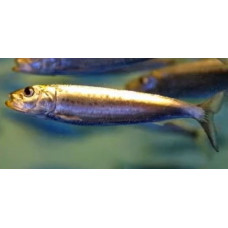Clupeidae is a family of fishes of the order Clupeiformes. Do not have barbed rays in the fins, scales cycloidal, lateral line absent, teeth poorly developed or absent. On the belly is developed keel. Includes 200 species. Inhabitants of tropical, temperate and cold seas. Some live in fresh waters or enter rivers to spawn. Lead a gregarious lifestyle. Body length rarely exceeds 50 cm. Hatch pelagic and, as an exception, bottom spawn (herring, Atlantic herring). They feed on plankton and small fish. Atlantic and Pacific herring and Ivasi are of minor commercial importance. Clupeidae occupy one of the leading places in the world catch, providing about 10% of the total fish catch.
Mostly marine fish, although there are freshwater and anadromous species. None of the species has scales on the head. The lateral line is short or absent and the teeth are unusually small, with some species having weak or absent teeth.
Clupeidae have a laterally compressed or flattened body, coloration is usually silvery, dorsum dark blue or greenish. The dorsal fin is single, located in the middle part of the back, pectoral fins are located at the lower edge of the body, pelvic fins - in the middle third of the abdomen (sometimes absent), caudal fin is notched. The absence of punctured scales of the lateral line on the body is characteristic, sometimes there are only 2-3 such scales just behind the head. Along the midline of the belly in many species stretches a keel of sharpened scales. Swim bladder is connected by a canal with the stomach, and the anterior end of the bladder is connected to the ear capsules of the skull by two outgrowths. There are upper and lower intermuscular ossicles.
Clupeidae are widespread from the Subantarctic to the Arctic, with the greatest biodiversity in the tropics and single species in cold waters. They are mostly small and undersized fish, less than 35-45 cm in length,[2] only a few passage fish can be 75 cm long. Clupeidae lay numerous eggs (up to 1,000,000 eggs in some species). In most species, eggs and larvae are planktonic. Adults usually swim in large schools. Clupeidae usually feed on plankton, with adults ranging in size from 2 cm to 75 cm.
After hatching, the larvae live among the plankton until their swim bladder is developed and the larvae develop into adults. Eggs and fry are not protected or defended by their parents. Adult fish usually live in large schools for defense against fish-eating predators such as birds, sharks and other predatory fish, toothed whales, marine mammals, and jellyfish. They also form bait pots.
Clupeidae
Tags: clupeidae




